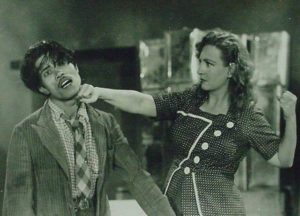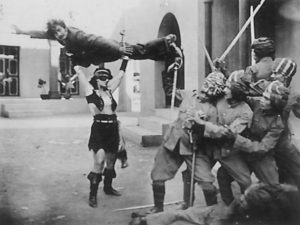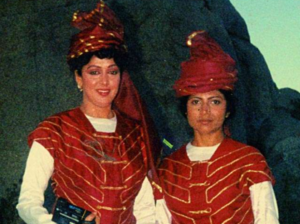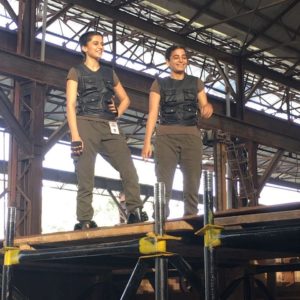Bollywood stuntwomen: Stories of struggle, injuries and sexism

The first stuntwoman to work in Indian cinema was an Australia-born actress and stuntwomen, Mary Ann Evans, also known by her stage name – Fearless Nadia
Leaping off cliffs, running through fires and jumping out of helicopters are all in a day’s work for Bollywood stuntwomen. Though male stunt artistes continue to dominate the celluloid, female stuntwomen say they feel more welcome than their predecessors.
“I got an opportunity to audition for a stunt for Aishwarya Rai in 1999 for an ad shoot where I had to do a couple of flips and jump from a height. They selected me on the first attempt, saying I was fair and my skin tone matched hers. Plus I could do the flips. I got paid INR 10,000 just for one day of the shoot. Those days INR 10,000 per day of shooting was much better than the average salary. It was maybe the salary of a well high-paying job. So that’s when I realised, hey why not make a profession out of my passion,’’ recollects Sanober Padriwalla, who has been working as a stuntwoman in Bollywood for last 20 years, while talking to Media India Group.
Similar to many other industries in the country, the Hindi film industry or Bollywood has always been a male-dominated arena, especially when it comes to performing stunts.
Stuntwomen in Indian cinema are nothing new, though. The seed for today’s healthy crop of several expert stuntwomen was sown almost a century ago, in 1935, to be precise. Curiously, the first stuntwoman to work in Indian cinema was not an Indian, but an Australia-born actress and stuntwomen, Mary Ann Evans, also known by her stage name – Fearless Nadia.
In the early 1930s, Evans started working in the circus and gradually transcended into Hindi film industry by mid-1930s. The tall, blue-eyed, blonde Evans was best known for portraying the masked and cloaked adventuress in Hunterwali (The Lady with Hunter) in 1935. She worked in over 50 Hindi films till her voluntary retirement after marriage. Evans is still remembered as the first superwomen of Bollywood for her fearless stunts and graceful presence on screen.
Another prominent stuntwoman of yesteryears was Reshma Pathan, popularly known as the Sholay Girl, performed her first stunt act in 1968 for the film Ek Khiladi BawanPattey (released in 1972) as a double for actress Laxmi Chhaya. Around the same time, Pathan also became the first female stunt artist to be allowed to join Movie Stunt Artist Association. “Pathan Ji opened new doors for us. I would have never thought of performing stunts in such a rigid and patriarchal industry if I wasn’t sure that a group of similar men and women was there to protect me, safeguard me and make sure that I am paid well enough. However, we still face more challenges in comparison to stuntmen for even getting our first audition,” Padriwalla adds.
As performing stunt requires extreme physical fitness, swiftness and lots of risks are involved, women are often discouraged from joining the industry and not just by their families. Ironically, often it was the women stars that lacked confidence in letting another woman do the stunt for them. “Many directors and even actresses themselves said that they didn’t feel confident enough to let me perform even once. They preferred to cast a male with wig and makeup as a stunt double to actresses rather than stuntwomen,” Padriwallaexplains.
Mastering the art of keeping calm while sinking into a 30-foot-deep lake without oxygen or being dragged off by a tiger isn’t easy. Stuntwomen have risked their lives and survived life-threatening injuries while doing their jobs on a film set. Padriwalla recollects several such instances.
“I’ve injured my spine thrice. The first, when I was new to the industry. I wasn’t wearing padding around my back because I didn’t know what it was and nobody told me I had to put it on either. It was a scene in which a man was chasing the heroine, who reaches the top of a building. She says, “Don’t come any closer or I’ll jump.” I jumped and hit my back on a rod. Had I been wearing some padding, the impact wouldn’t have been as much. I fractured my back twice. But all of this is a part of my job and I can do little apart from being more cautious and try to recover faster,” she says.
Padriwalla also explains that prevalent sexism and how a woman should look is another major hurdle in stuntwomen’s careers. Just like the leading actresses of the film industry, stuntwomen are expected to look unrealistically skinny, fair and at the same time, be tough and healthy enough to endure near-fatal accidents and recover injuries.
Padriwalla goes on to say “Very often, stuntwomen have to put on a swimming costume or skimpy clothes, similar to the actresses and are expected them to perform some difficult action. It increases the likeliness of getting injured or at least badly bruised.”
“You also get told, “Hey you look so skinny, it’s a perfect match for our actress.” And then the next statement is, “Since you’re so skinny are you sure you’ll be able to do the stunt?” So it’s a contradiction and sometimes you feel so tired of such sexist remarks and stereotypical behaviours. Other times, even if you’re super skinny, wearing a harness adds an inch to your figure. It’s natural, there are buckles and belts and buttons. But there are times people call you fat in that avatar. Even if you’ve just jumped off a 20-storey building, there’s someone going, “But she looks a size bigger than the actress,” Padriwalla adds.
Amid the dark clouds of sexism and injuries, there is a silver lining too. Since the last two decades, the stunt industry in films has changed manifold. Earlier, stunt artists didn’t have any insurance or health cover in case of an injury, accident or loss of life. But MSAA has been working towards making the industry safer for all. Stunt artists are being paid well and are provided with health cover and insurance against loss of job or life by film producers and production houses. MSAA has also been trying to maintain gender balance in their organisation.
“Since the time I got into MSAA, things have been better for me. Finances, health recovery and insurance is taken care of by the organisation. The growth of a number of women in the stunt industry has been slow but steady. In fact, it is a matter of pride that the current President of MSAA is a woman – Lubna Yusuf Khan,” Padriwalla sums up.












